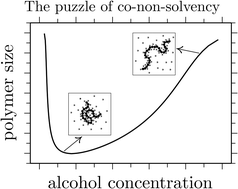Reply to the ‘Comment on “Relating side chain organization of PNIPAm with its conformation in aqueous methanol”’ by N. van der Vegt and F. Rodriguez-Ropero, Soft Matter, 2017, 13, DOI: 10.1039/C6SM02139E
Abstract
In a comment van der Vegt and Rodriguez-Ropero (vdVRR) challenged our explanation of the co-non-solvency effect of PNIPAm in aqueous methanol solutions. They argue, based on a careful selection of published studies including some of their own, that direct repulsions between the different constituents are sufficient to understand this phenomenon. According to vdVRR, the emerging view of entropic collapse, put forward by Flory (1910–1985) to explain common polymers in poor solvents, would be enough to explain co-non-solvency. In this reply we attempt to bring this discussion into firmer grounds. We provide a more comprehensive view of available experimental, numerical and theoretical results and review basic concepts of physical chemistry and of statistical mechanics of polymer collapse that show how methanol mediated attractions between chain monomers are required to understand this fascinating behavior.



 Please wait while we load your content...
Please wait while we load your content...